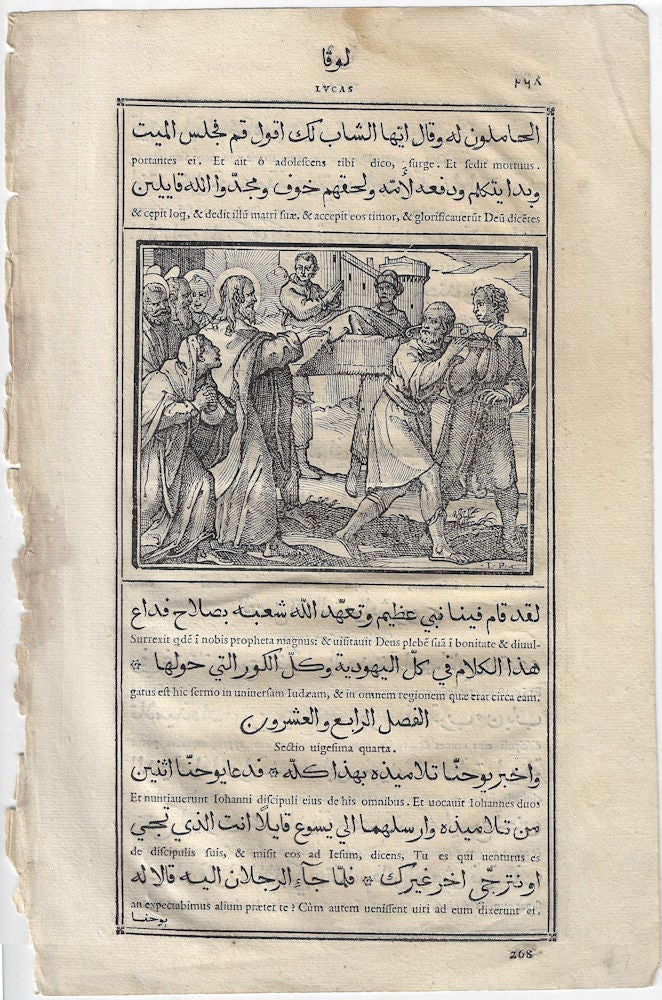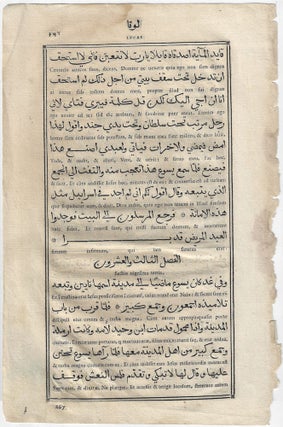Arba’at Anajil Yasu’ al-Masih Sayyidina al-Muquddasah. Sacrosancta quatuor Iesu Christi D. N. Evangelia (The Four Gospels of Jesus Christ); Bilingual leaf from an Arab-Latin Book of the Gospels
Rome: Medici Oriental Press, 1591. Disbound. This 20 x 30.4 cm (approximately 8” x 12”) leaf is from Arba’at Anajil Yasu’ al-Masih Sayyidina al-Muquddasah. Sacrosancta quatuor Iesu Christi D. N. Evangelia (The Four Gospels of Jesus Christ). Faint dampstain at top margin. Includes an attractive woodcut illustration (5” x 4”) of Luke 7:11-17, Jesus raising of the son of the widow of Nain. In 1584, with the endorsement of Pope Gregory XIII, the Orientalist Giovanni Battista Raimondi, founded the Medici Oriental Press in Rome, which published books in Arabic, Syriac, Hebrew, Ethiopic and Persian in an attempt to spread the Gospel throughout the East. This book was published in two versions in 1591. One, in Arabic only text was printed for evangelical use in the east. The other was printed in both Arabic and Latin and intended also to be used as a teaching vehicle for Europeans scholars to learn Arabic. Both were filled with illustrations, and those that depicted God created discontent with Muslims and proved detrimental to the cause. It is believed that as a result many of the books, especially the all-Arabic versions were destroyed. Like all early printed editions of the Arabic Gospels, the text is based on the Alexandrian Vulgate (see Darlow & Moule’s Historical catalogue of the printed editions of Holy Scripture in the Library of the British and Foreign Bible Society #1636) The book was reprinted in a larger folio edition, 26 x 36.5 cm (approximately 10¼” x 14¼”) in 1619. The Arabic font used in this book was designed by Robert Granjon and was the first successful Arabic printing font. The running titles (page headlines) first show the names of Gospels in Arabic with Latin underneath. The press employed two illustrators for this book, Antonio Tempesta and Leonardo Parasole. The initials “L.P.” in the lower right corner of this illustration indicate that it was created by Parasole. Luke 7:11-17 reads 11 Soon afterwards Jesus went to a town named Nain, accompanied by His disciples and a large crowd. 12 And when He arrived at the gate of the town, a funeral procession was coming out. A young man had died, the only son of his mother, and she was a widow. And a large crowd from the town was with her. 13 And when the Lord saw her, His heart was filled with pity for her, and He said to her, "Do not weep". 14 Then He walked over and touched the coffin, while the pallbearers stood still. Jesus said to the dead man, "Young man, I say to thee, arise!" 15 And he who was dead, sat up and began to talk, and Jesus gave him back to his mother. 16 Then they all were filled with awe and praised God. And they said, "A great prophet has risen among us", and "God has visited His people. 17 This news about Jesus went out through all the country and the surrounding territory." For more information, see the Sokol Books website. Very good. Item #010021
Price: $450.00







